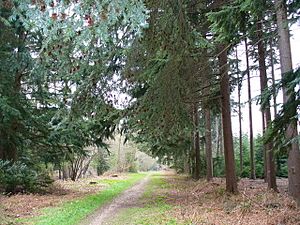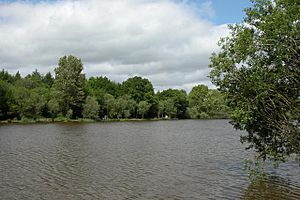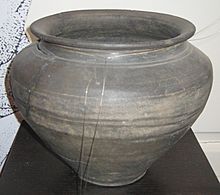Alice Holt Forest facts for kids
Alice Holt Forest is a special royal forest located in Hampshire, England. It's about 4 miles (6.4 km) south of Farnham, Surrey. Long ago, it was mostly a forest of ancient oak trees. In the 1700s and 1800s, these oaks were very important. Their wood was used to build ships for the Royal Navy.
Today, the forest is mostly filled with conifer trees, like pines. The Forestry Commission started managing Alice Holt Forest in 1924. A research station was set up there in 1946. This station is in Alice Holt Lodge, which used to be a large manor house. Since March 31, 2010, Alice Holt Forest has been part of the South Downs National Park. It's known as the most northern entrance to this beautiful park.
Contents
What's in a Name?
The name Alice in Alice Holt Forest likely comes from a person. It's thought to be from Ælfsige, who was a Bishop of Winchester in AD 984. His church group had rights over the forest land. Over time, the name changed. You can see this in old documents:
- Alfsiholt (before the Norman Conquest and in 1169)
- Alfieseholt (1242)
- Halfyesholt (1301)
- Aisholt (1362/63)
- Finally, Alice Holt (1373)
The second part of the name, Holt, comes from an old English word. It means a wood or a thicket, usually a forest managed for one type of tree.
Some other ideas for the name Alice have been suggested. These include words like alder (a type of tree) or ash (referring to ash from Roman pottery kilns). But these ideas are not as likely to be true.
Nature and the Land
Alice Holt Forest is in the western part of an area called the Weald. It sits in a valley made of Gault clay. This clay valley is between two different types of hills. One is a chalk ridge, and the other is made of malmstone (Greensand). These hills are often called "hangers" because they are steep and have woods on them.
The forest is on a low, flat area. Its edges slope steeply. Here, you can find stony deposits from ancient rivers. These deposits sit on top of the heavy, wet Gault clay.
Alice Holt Forest was famous for its oak trees. These trees grew well on the thick Gault clay. In the 1700s, a famous nature expert named Gilbert White lived nearby. He compared Alice Holt to the nearby Woolmer Forest. He noted that Alice Holt had strong, muddy soil with good grass and large oak trees. Woolmer, however, was sandy and barren, with mostly heath and fern, and no large trees.
Today, the forest is mostly planted with conifer trees. The Forestry Commission says Alice Holt Forest Park covers about 851 hectares (2,100 acres). Most of this is Corsican pine. But about 140 hectares (350 acres) of oak trees, planted in 1815, still remain. Some broad-leaved trees have also been planted again. This is part of a plan to bring back different types of trees.
Past Discoveries and History
A few old tools found here show that Stone Age hunters used the area. This was during warmer times between ice ages, about 7,000 years ago. Some Mesolithic flints also show early hunter-gatherers lived here. There are a few Iron Age burial mounds. But the area didn't have many people living in it before the Roman times. This was because the land wasn't very good for farming.
During the Roman occupation of Britain, many kiln sites and clay pits were here. These were used to make pottery. Major A.G. Wade explored some of these sites in the 1930s and 40s. More detailed research happened in the 1970s. This research showed that Alice Holt and the surrounding areas were very important. They were one of the biggest places for making everyday pottery in Roman Britain. This pottery supplied up to 60% of all pottery found in places like Staines and London. It was sent all over south-east England from AD 60 to the early 400s. The forest even gives its name to a special type of Roman pottery called Alice Holt Pottery.
Alice Holt Forest was under Forest Law from the time of William the Conqueror. This meant it was a special forest owned by the king. It stayed a Royal Forest for a long time.
Alice Holt and Woolmer forests were very close. They were usually seen as one forest from medieval times onwards. They had the same management and a single lord warden. They were even known together as the Royal Forest of Alice Holt and Woolmer.
Old documents from the Middle Ages mention deer and timber in the forest. The first detailed survey was in 1635. It showed the total area was about 15,493 acres (6,270 hectares). This was thought to be similar to the year 1300. By 1790, not much had changed, though 6,799 acres (2,751 hectares) were privately owned.
From the 1770s, Alice Holt and Woolmer forests were mainly used to grow oak for the Royal Navy. But the trees had been neglected. In 1811, the forest's leader was removed. Four years later, the Office of Woods started a huge re-planting project. They planted oak trees on 1,600 acres (650 hectares) of Alice Holt. During the Napoleonic wars, oak logs were transported. They went 10 miles (16 km) overland to the River Wey at Godalming, Surrey. From there, they were shipped to the Thames dockyards in London.
Many of the oaks planted in 1815 were still there 100 years later. But many were cut down during World War I. Between the two world wars, and especially during World War II, conifers replaced the oaks. When the Forestry Commission took over in 1924, Alice Holt was smaller, covering 2,142 acres (867 hectares).
On March 31, 2010, Alice Holt Forest became part of the South Downs National Park.
Recently, oak wood from Alice Holt was used for a special project. It helped build a copy of Shakespeare's Globe Theatre in London.
Special Nature Areas
The forest is a special place for nature. It's called a Site of Interest for Nature Conservation. Part of it is set aside for research. Scientists study things like how forests affect carbon, environmental change, and wood fuels here.
Fun Things to Do
Alice Holt Forest is one of the most popular places managed by the Forestry Commission. Over 290,000 people visit each year!
- It has a cafe.
- There are natural play areas and outdoor structures for children to explore.
- You can rent bikes.
- There are over 8 miles (13 km) of marked trails for walking and cycling.
- Every Saturday, a timed 5 km (3.1 mi) run called Parkrun takes place here. About 233 runners join each event.
- Horse-riding is allowed in some parts of the forest.
A very successful project here is Cycling for All. This project helps people of all ages and abilities enjoy cycling. It helps them improve their health and well-being. The Forestry Commission's partner, Cycling UK, sees Alice Holt Forest as a top example for cycling. It's used as a model for other projects around the country.
See also
 In Spanish: Alice Holt Forest para niños
In Spanish: Alice Holt Forest para niños




